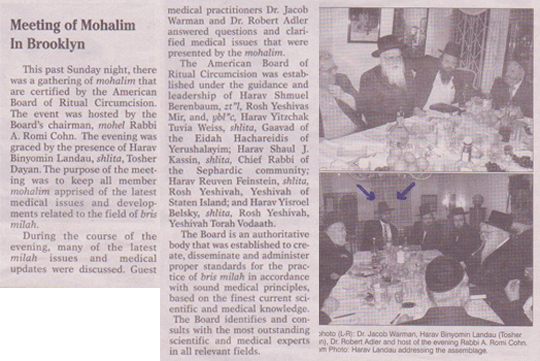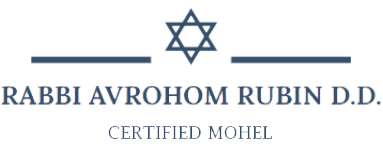Eliyahu Hanavi At His Side
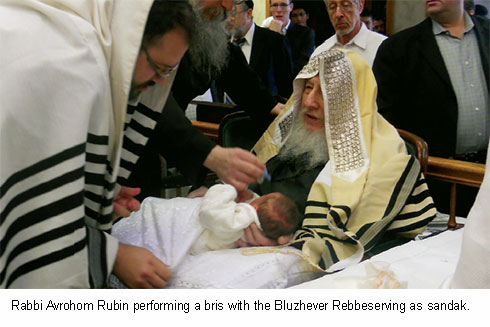
Conversation With Mohel Rabbi Avrohom Rubin
He has attended brisos across the United States, Canada, Eretz Yisrael and even in far-flung locations such as the Caribbean, but one of Rabbi Avrohom Rubin’s most memorable brisos took place in Yerushalayim. As his dexterous hands performed the bris milah and his mind was focused on the proper kavanos, the eyes of the sandak, Harav Yosef Shalom Elyashiv, zt”l, observed his every move. Upon completion of his sacred task, Rabbi Rubin looked up at the Gadol Hador, who uttered two words: “Mohel mumcheh.”
Mission of a Mohel
Avrohom Rubin was raised in Staten Island, where his family shared close ties with Harav Moshe Feinstein, zt”l, and with his sons, shlita, Harav Dovid and Harav Reuven Feinstein. It was during his high school and beis medrash years learning in the Mirrer Yeshiva in Flatbush that he developed a close relationship with Harav Shmuel Berenbaum, zt”l, even learning with him b’chavrusa. It was Harav Berenbaum who would ultimately encourage and arrange for the young Avrohom Rubin to study to become a mohel. Avrohom later learned at Yeshivas Mir in Eretz Yisrael and, after marrying, returned there to live.
“When my second child, a son, was born I approached my son’s mohel to please teach me milah,” says Rabbi Rubin. “He told me not to waste my time; that it’s a hard business and I won’t be matzliach. I told him I wasn’t doing this for business. It’s klei kodesh, and if I could give something to the klal, it’s something I would like to do.”
Rabbi Rubin called his Rav, Harav Berenbaum, and recounted the conversation. “Reb Shmuel told me to ask someone else,” Rabbi Rubin relates.
Soon after, the Rubins relocated from Eretz Yisrael to Bridgeport, Connecticut, where he learned in kollel. He received guidance from Harav Moishe Epstein, the Rabbi of Bridgeport, a noted mohel. But since Rabbi Epstein was no longer practicing milah, Avraham opted to serve the klal by joining the local chevrah kaddisha instead.
It was a few years later, when Rabbi Rubin relocated to his hometown of Staten Island, that he began to actualize his dream of bringing children into the covenant of Avraham Avinu. He first apprenticed with Rabbi Shimon Hess, the well-known mohel of Bais HaTalmud in Bensonhurst, Brooklyn. After a conversation with his talmid, Harav Berenbaum, called Rabbi Romi Cohen, a world-renowned mohel, to ask him to undertake teaching Rabbi Rubin. “I followed Rabbi Cohen across America for a year and a half,” says Rabbi Rubin. “I assisted him in brisos in homes, shuls, Columbia Hospital, Methodist Hospital, and even on adults.”
Rabbi Rubin also spent many hours observing Harav Yisroel Belsky, shlita. Harav Dovid Feinstein guided and coached him and Harav Reuven Feinstein refers people — particularly Staten Islanders — to him all the time. He has performed brisos with numerous noted personalities serving as sandak, including Harav Elyashiv, zt”l, and, ybl”c, Harav Chaim Kanievsky, shlita. Even after performing a few hundred brisos, Rabbi Rubin still views each one as a special event. “It’s a Yom Tov for me,” he enthuses. “There’s no greater feeling I [can] have. It’s hard to describe the unbelievable, elated feeling of knowing that you were machnis a child into his first mitzvah. I go to the mikveh any day I perform a bris. Sanctity and kedushah are important, and the entire day is more chashuv to me — especially Shabbos and Yom Kippur brisos.
“I feel that we must understand what we’re doing — the kedushah you put in is what the child ultimately receives. … [No matter who the baby is, or who his parents are,] every bris has its own unique moment, even if I do a few [brisos] in a day.”
Working With Eliyahu Hanavi
“When I first began doing brisos,” says Rabbi Rubin, “I asked Harav Shmuel Berenbaum what I should have in mind when performing a bris. He told me that because Eliyahu Hanavi attends each bris, as the mohel, I have a strong koach hatefillah and I should use that power of prayer to daven for people who have not yet been blessed with children. I have a list of names I daven for at every bris, and because of Reb Shmuel’s words, I put a lot of effort into that tefillah.”
An acquaintance of Rabbi Rubin’s, who had been married for four years and had not yet had a child, requested that he be added to his list. A few months later, he was asked to do a Yom Kippur bris in Flatbush. Rabbi Rubin left his family and stayed in Flatbush. He would have to trek two miles on that sweltering Yom Kippur.
Twenty minutes before the fast, he drove to the home of the newborn to deposit his mohel bag there. The grandmother of the baby off handedly made a comment that startled him. He realized that the mother had misunderstood one of his routine questions when checking the baby, but now he realized that due to the nature of the baby’s birth, it was not permitted for the bris to take place on Yom Kippur as planned; it would have to be postponed. The day after Yom Kippur, the bris took place in the afternoon. Still feeling the holiness of Yom Kippur, and in particular because he felt he had been protected from transgressing this holiest of days, Rabbi Rubin felt a tremendous hisorerus. As he launched into his Mi shebeirach for the many childless couples on his list, he realized his acquaintance’s name was missing. Thinking perhaps he had the wrong list, he pulled out the list he kept in his backup mohel bag. The name was missing from this list as well.
“I went to daven Minchah at the shul where this individual davens. I approached him and told him, ‘You’re off my list. You don’t need my tefillos.’ He gave me an odd look but stayed quiet. Later on, he called me and told me, ‘Aside from our doctor, my wife, and me, you are the only one to know that my wife is expecting.’”
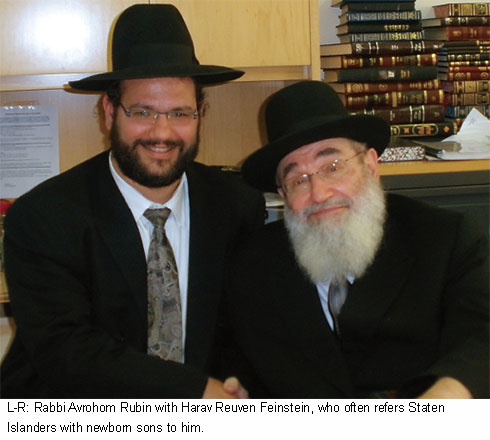
A Priceless Mitzvah
The mitzvah of milah is so dear to Rabbi Rubin that he doesn’t charge a fee. One day, he received a call from a woman in Staten Island asking him to perform a bris on her grandson.
“I arrived at this home,” recounts Rabbi Rubin. “The father of the baby wasn’t even Jewish, and the bris was being done largely at the grandmother’s urging. The grandmother came in and asked, ‘Rabbi, how much do you charge?’ ‘This is such a holy thing,’ I told her, ‘I don’t charge. If you want to give something, you can, but I don’t put a price on it.’
“A few minutes later she returned to the room and said, ‘Rabbi, I realize how important the mitzvah is. I really went all out,’ and she handed me an envelope. When I got home and opened the envelope, there was a $50 bill inside. Imagine if I had told her even a relatively low price for a bris, like $200. It would have been a chillul Hashem.” Three years later, Rabbi Rubin received a call from a non-religious woman asking him to come do a bris on her grandson at her home in New Jersey. It was to take place the day after Hurricane Irene, and he had to travel in from the Catskills. Most of the roads were flooded and impassable. Not one to allow anything to deter him from his holy mission, Rabbi Rubin, driving his beat-up minivan, proceeded through a roadblock into a deluge of water in the roadway. “In the worst case, I knew that I’d get a well-deserved ticket,” recalls Rabbi Rubin wryly. “The sanctity of bris milah was more important to me than that.
“I pulled up to a sprawling mansion, and when I walked inside, I recognized the woman, who had apparently moved from Staten Island. I was now invited to do the bris on the second child of her daughter and non-Jewish son-in-law. When I got home, I opened the envelope she had handed me. It contained one thousand dollars, along with a note thanking me for doing the bris, and an apology. She explained that after I had performed the bris on her first grandson, she had told a friend that she had generously paid the mohel fifty dollars. Her friend reprimanded her for paying so little, so she wanted to make it up to me now.”
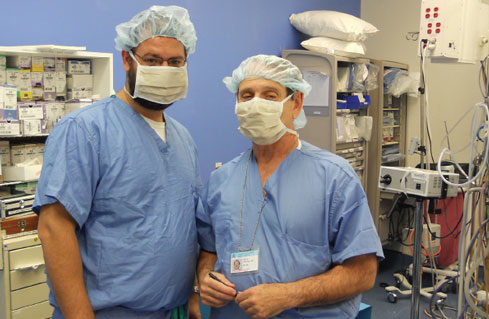
A Bris Fit for a Prince
The most elaborate bris Rabbi Rubin attended served as a personal lesson in dan l’chaf zechus. He received a call from a fellow who inquired about his prices. “When he heard that I don’t charge,” relates Rabbi Rubin, “he told me, ‘I will give what I can, because I know you’re coming in from the mountains.’ I walked in to a non-kosher restaurant that had been kashered. It was an extremely ostentatious affair, where every type of food imaginable was displayed and every piece of cake cost a minimum of five dollars. On my way out the baby’s father handed me an envelope stuffed with bills.
“I got home and opened the envelope. It was filled with small bills totaling $144, which I realized was eight times chai. A few weeks later the father of this baby phoned me. ‘You’re probably thinking that I am cheap for making such a lavish affair and paying you such a measly sum,’ this man stated. ‘But I grew up in foster homes and I work as a driver. I have no money to my name. The night before the bris, a long-lost uncle contacted me to wish me mazel tov and offered to pay for the bris. He made the bris by his standards, but I was embarrassed to ask him for money for the mohel too, so I gave you what I scraped together.’”
Following the First Avraham
Sitting in the pediatrician’s waiting room with his young daughters, an apparently non-Jewish woman sitting with her own daughter and grandchild struck up a conversation with Rabbi Rubin and his children. Rochel Leah, his daughter, then seven years old, turned to the woman and commented, “You know, you look Jewish.” The woman appeared shocked and said, “In all my years, no one has ever commented on my religion, let alone a seven-year-old.” She went on to admit that her mother had been a Holocaust survivor, but that she had never had any connection with Jews.
As the Rubins made small talk, they learned that the woman’s daughter was her only child, and that she had a grandson, in addition to the young granddaughter who was waiting to see the doctor. Rabbi Rubin inquired whether he had had a bris. They explained that the boy had had a hospital circumcision performed on the second day of his life. Rabbi Rubin, with his unpretentious, magnetic personality, gained the confidence of the mother and grandmother and explained to them the importance of a proper milah. By the time the Rubins saw the doctor, he had them convinced. A few days later, this young boy whose family had no connection or agliation with religion underwent an authentic bris.
Being a mohel is a mission that Rabbi Avrohom Rubin undertakes with the same mixture of sanctity, awe, pride, and significance, whether with the Gadol Hador or in the home of a non-religious Jewish family, because he knows that Eliyahu Hanavi is standing at his side as he brings yet another Jewish neshamah into the holy covenant of Avraham Avinu.
A Dream Mohel
By Dave Kohn
12/17/08
He’s agreed to sit down with me and discuss his Bris methods. He resides in Staten Island NY with his wife and five children. His outgoing personality is what attracts all who meet him. He has a great sense of responsibility and his sense of humor can’t be matched. He juggles being a Father a Rebbi and community man, while at the same time aiding and circumcising hundreds of babies every year.
What makes Rabbi Rubin such a sought after Mohel? It’s hard to pinpoint the main reason. Besides for his relaxed personality, his total devotion and his uncompromising self dedication, is his expertise and technique in Bris Milah that can’t be beat. He ordained for more than 2 years under Mohel Romi Cohn, one of North America’s leading Mohelim and Chairman of The American Board of Ritual Circumcision. Rabbi Rubin has gained the knowledge and expertise in performing Bris Milah in less than 20 seconds, making his audience wonder in shock, how he could’ve finished the whole procedure in such a short amount of time, leaving the baby in such a content position almost always falling asleep, even before they begin the Bris blessings. When asking Rabbi Rubin, how, the baby after undergoing such a procedure could feel so relaxed and content? He simply replies “When you perform Bris Milah with such care devotion and feeling, even the baby feels it and after properly wrapping up the baby, he feels secure and comfortable”. Rabbi Rubin explains, “When doing a Bris Milah on a child, one must realize the magnitude of the Mitzvah he’s performing and therefore the meaning and procedure, take on a whole new level. One must regard a circumcision as a surgical procedure, strictly adhering to the highest standards of sterility, avoiding any and all possibilities of infection G-d forbid.
Indeed after observing his procedure, besides for his obvious expertise, you have the feeling that your child is in the safest hands possible. Each and every instrument used is prepackaged and fully sterilized, but the best of all is the sanctity and holiness Rabbi Rubin brings to the Bris ceremony. When asking how he could be reached, he replies, either call me at (646)709-1374 or through e-mail at rabbi@mohel-bris.com . He services the NY tri-state area and beyond, with total devotion and self sacrifice. You could see more about Rabbi Rubin at www.mohel-bris.com. As a parent, I have finally found a Mohel with devotion, care and the best of service.
